序章

In the era of pursuing green environmental protection, energy saving has become an indispensable part of our lives and work.
So, how can we achieve maximum energy saving while enjoying the gorgeous visual effects brought by LEDディスプレイ? This article will reveal the secret of LED display power consumption for you.
目次
1. The basic principle of LED display power consumption
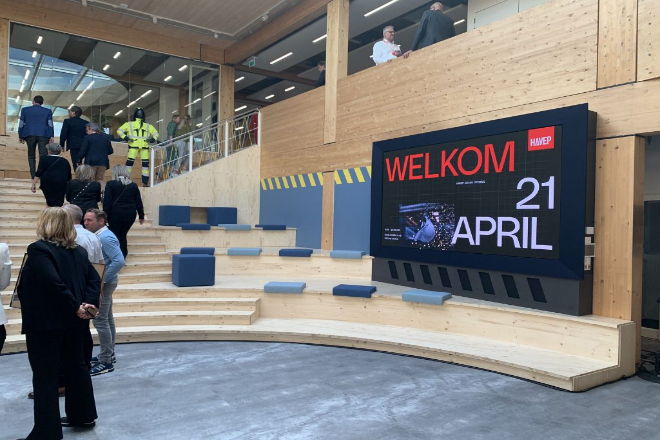
The power consumption of an LED display is the electricity it uses when it works. There are drive circuits, LED lamp beads, and control systems on display.
The drive circuit supplies power to the lamp beads, and the control system directs them to emit light.
The lamp beads are the protagonists of light emission, and these three parts together determine how much power the display consumes.
の 消費電力 of the display is mainly composed of three parts: the drive circuit, LED lamp beads, and the control system.
The drive circuit accounts for 10% – 30% of the power consumption, and its main task is to provide the lamp beads with appropriate current.
LED lamp beads account for 60% – 80% of the power consumption, which is the biggest power consumption because they are the main body of light emission.
The control system accounts for 5% – 10% of the power consumption and is mainly responsible for receiving signals and directing the drive circuit.
The more functions the display has, the higher the power consumption of the control system.
The higher the 輝度, the greater the power consumption of the display.
Because the brightness depends on the luminous intensity of the lamp beads, and the luminous intensity is proportional to the current.
The larger the current, the higher the power consumption. The brightness can be adjusted to save energy in different scenarios.
For example, if the indoor light is dim, lowering the brightness can save electricity.
When the outdoor sunlight is strong, high-efficiency lamp beads and drive circuits can be used to save energy.
During stage performances, adjusting the brightness according to the lighting can both meet the needs and save electricity.
2. Key factors affecting the power consumption of LED display screens
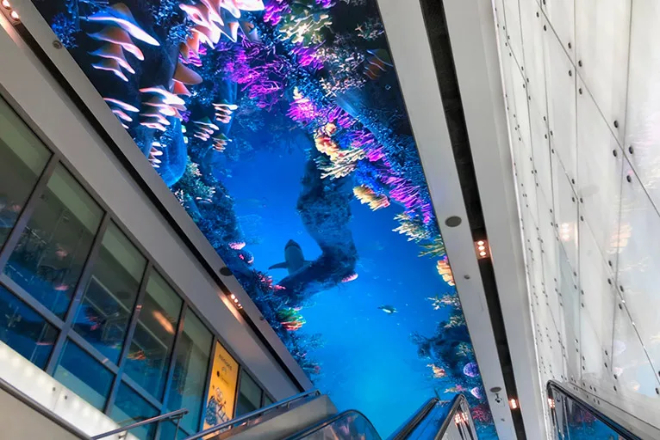
1). Types of LED lamp beads
LED lamp beads are the core components of the display screen. Different types of lamp beads have significant differences in power consumption.
Let’s talk about SMD lamp beads first. This type of lamp bead is like our common small light bulbs, and it can be seen everywhere.
However, its power consumption is relatively high, just like a small light bulb. Although it is bright, it is more “power-consuming”.
Let’s take a look at COB lamp beads, which are a bit like “teamwork”. COB lamp beads integrate multiple small chips together, which not only reduces packaging losses but also makes heat dissipation better.
It’s like many people sharing the work together, which is more efficient and consumes less power.
There are also Mini LED lamp beads, which are very small, like miniature light points. Because of their small size, more lamp beads can be packed into a unit area.
Although the power consumption of a single Mini LED lamp bead is very low, the overall power consumption may also increase when the number increases.
It’s like installing more small lamp beads on a small screen. Although each one is very power-saving, it adds up to a lot.
However, there is now a kind of high-efficiency LED lamp bead, which is like upgrading the “energy-saving mode” by optimizing the structure and materials.
These lamp beads can consume less electricity at the same brightness, thereby reducing the power consumption per unit area. It’s like lighting up a room.
These high-efficiency lamp beads only need less electricity to achieve the same brightness, which is both energy-saving and environmentally friendly.
2). Drive circuit design
The drive circuit is like an administrator who “feeds electricity” to the lamp beads. Its design has a significant impact on power consumption.
At present, the most commonly used is a constant current drive, which ensures that each lamp bead works at a fixed current.
This is like allocating a fixed “meal amount” to each lamp bead, making the brightness and color more consistent.
However, if the current is too large, the lamp bead will “eat” too much, and the power consumption will naturally increase.
Constant voltage drive is a bit different. It provides a stable voltage for the entire circuit, just like “providing food expenses” to the lamp beads.
The power consumption of this method is relatively low, but voltage fluctuations may cause different brightness. Just like when the voltage is unstable, the lamp beads may be bright and dark.
Now, there is also an intelligent drive circuit that is very powerful. This circuit can “observe” how bright the display needs to be in real-time and then automatically adjust the current.
For example, when displaying black or dark pictures, it will automatically “eat less” and reduce the current, thereby significantly reducing power consumption.
This is like a smart administrator who reasonably allocates resources according to actual needs, without waste, and can ensure the normal operation of the lamp beads.
3). 解決 of the display screen
High-resolution display screens are like a “luxury package” of pixels, with clearer and more delicate pictures but more lamp beads.
Because there are more lamp beads, it is naturally more “power-consuming”. It is like installing more lamp beads on the same screen to display a more detailed picture, and the power consumption will naturally go up.
However, if the display content requirements are not high, such as simply displaying text or not too complicated patterns, it is better to choose a display with medium resolution.
This can not only meet basic display needs but also save a lot of electricity. It is like not needing a high-definition large screen to watch a small video, and using an ordinary screen is enough.
In addition, energy can be saved by optimizing the display algorithm. For example, reducing the number of high-brightness pixels so that a lot of electricity can be saved even if it looks similar.
This is like when painting, only using bright colors where needed and dark colors in other places, which can achieve the effect and save pigments.
3. Technical trends of low-power LED displays
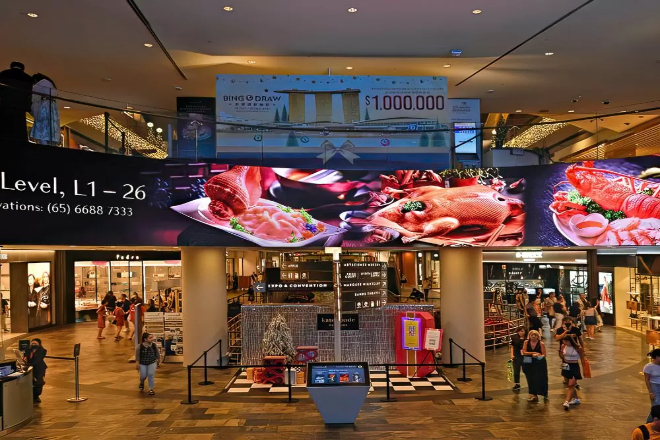
1). 新素材の応用
Now, some novel materials are making LED displays more energy-saving and better-looking.
For example, quantum dots, this material can make the screen color more vivid and not consume electricity.
There is also OLED, which can emit light by itself and does not require additional backlight.
In this way, the screen is not only thinner but also more energy-saving. The emergence of these materials makes the display screen look good while saving a lot of electricity.
2). Energy-saving chip technology
Today’s chips are getting smarter and smarter. Low-power driver chips and control chips are like “energy-saving housekeepers” for display screens.
These chips can automatically adjust the current and voltage according to the content displayed on the screen to avoid wasting electricity.
For example, some chips can automatically adjust the power supply according to the brightness and color of the picture, which can save a lot of electricity.
Moreover, these chips are constantly improving, making the display screen more and more energy-saving.
3). Intelligent dimming technology
Intelligent dimming technology is like installing a “little eye” on the display screen, which can automatically adjust the brightness according to the surrounding environment and display content.
Ambient light sensing dimming can automatically adjust the screen brightness according to the intensity of the light outside.
For example, in the sun, the screen will automatically brighten; in a dark place, the screen will dim, which saves electricity and does not hurt the eyes.
Dynamic dimming is smarter. It can adjust the backlight intensity in real-time according to the content displayed on the screen, such as the light and dark scenes of the video.
So that the screen is bright when it should be bright and dark when it should be dark, which can also save a lot of electricity.
4. Power consumption selection strategy in different application scenarios
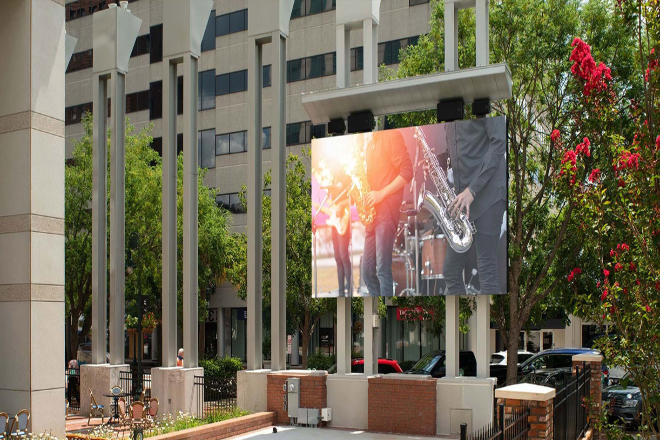
1). 屋外用LED広告スクリーン:
Outdoor advertising screens must be bright enough to attract people in the sun.
But if they are bright, the electricity bill will be high, and the equipment will easily heat up. Therefore, high-efficiency LED chips must be used to emit light with less electricity.
Install a light sensor, and the screen can automatically adjust the 輝度 according to the light.
It will be darker when it is dark and brighter when it is light. It is energy-saving and smart.
Heat dissipation is also critical. If the equipment is “cool”, it will have a longer life and save electricity.
Using energy-saving drive circuits, current loss is reduced, and power conversion is more efficient.
In this way, the advertising screen can be dazzling, energy-saving, and durable.
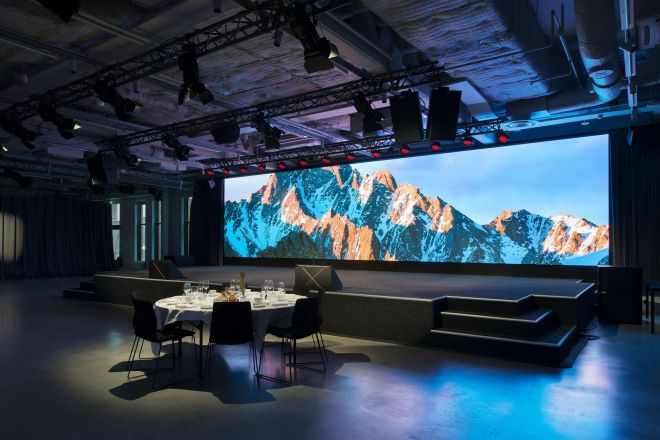
2). Indoor commercial display screens:
Indoor commercial display screens are used in shopping malls, conference rooms, and other places.
The light is not as strong as outdoors, and a brightness of 300-800cd/m² is enough.
But these screens have to be turned on all the time, the power consumption is high, the electricity bill is expensive, and the equipment is easy to break.
Therefore, when choosing a screen, choose a screen with appropriate brightness according to the actual light, and don’t waste electricity.
OLED screens are pretty good. They can emit light by themselves and save power, especially when displaying black.
Many screens have energy-saving modes, which automatically dim or sleep when not in use, which can save a lot of power.
Don’t let the screen display bright content all the time. Arrange the display content reasonably.
The screen burden is small, and the power consumption is naturally low. In short, indoor commercial display screens must meet the needs, save power as much as possible, be used for a long time, and spend less.

3). Traffic signal screen:
The traffic signal screen is the “commander” of urban traffic. It must be online 24 hours a day and must be highly reliable; otherwise, the traffic will be chaotic.
But at the same time, it must save power. If it is always on, the power consumption is high, the equipment is easy to heat up, the life is short, and the electricity bill is high.
Therefore, you have to choose a high-quality LED chip that can remain stable during long-term operation.
Low-power drive circuits and control chips can be used to reduce energy consumption. Heat dissipation is very important.
If the equipment is “cool”, the life will be long, and it can save power.
Regular maintenance and inspection are also critical to detect small problems in time to prevent them from becoming major failures.
In this way, the traffic signal screen can be used online 24 hours a day, which is stable and power-saving, ensuring smooth urban traffic.
5。結論
Through the introduction of this article, I believe you have a deeper understanding of the power consumption of LED display screens.
Whether in outdoor advertising, indoor commercial use, or traffic signals, choosing a suitable power consumption strategy can not only save electricity bills but also extend the life of the equipment.
最後に、LEDディスプレイスクリーンについてさらに詳しく知りたい場合は、 ご連絡ください。
